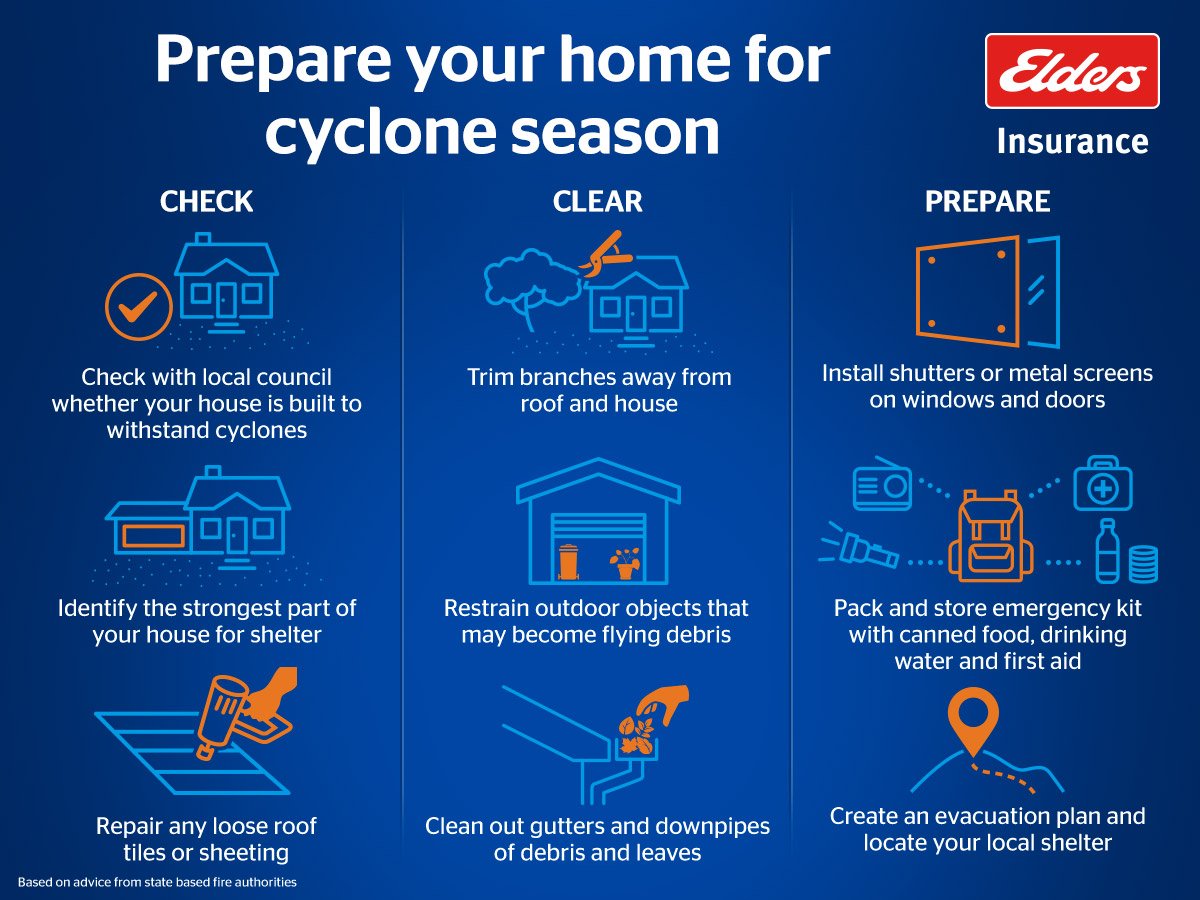16 April 2024
This article is intended as a general guide only. You should consult your state fire and emergency services for further information.

Australia’s cyclone season traditionally occurs in the northern areas of Australia between November and April, however preparing for a cyclone can start before there is an immediate threat.
What are cyclones?
Tropical cyclones start out as low-pressure systems that occur over warmer tropical oceans, including the oceans surrounding the northern and western areas of Australia. A low-pressure system draws energy from the warm waters, forming a convection current of gale force winds and moisture that rotate around a calm centre known as the cyclone eye.
A cyclone system travels as it picks up power and while cyclones can start and end over the oceans, unfortunately for us they can also move towards land. Torrential rain and flooding, tidal surges and destructive wind speeds of up to 280 kilometres per hour can cause loss of life, as well as extensive damage to property and communities.
Unlike many weather conditions, meteorologists can identify cyclone formation well in advance as they take shape over northern oceans before tracking towards our coastlines. This gives valuable time for preparation and public warnings to be issued for what is one of nature’s most furious challenges.
Prepare your house and property for cyclone
If you live in a cyclone prone area, especially if you have recently moved, The Bureau of Meteorology advises checking with your local council or building authority that your home and other buildings have been constructed according to the Cyclone Rating building codes, and whether your property is located in a storm surge area. Knowing this information about your home makes a difference to how you proceed when a cyclone is approaching.
The following upgrades and maintenance are recommended by state-based emergency services to minimise damage to your home during a cyclone:
Check if your insurance policy covers damage, power surges, flooding, tidal surges, and debris removal. You might also want to check your car and other vehicles, such as caravans, are adequately covered by insurance.
Remember, even a plastic bucket can be dangerous when travelling at high speed so tie down or bring inside any loose building materials, toys, garden furniture and rubbish bins before a cyclone hits, the WA Department of Fire and Emergency Services (DFES) advises.
Evacuate or stay, know your plan
It is essential you have a plan and everyone in a household knows what to do on the approach of a cyclone, when to do it, and why. This downloadable Household Emergency Plan by the Northern Territory Emergency Service is a useful guideline on what your plan should cover.
Make sure your family recognises the Standard Emergency Warning Signal, which is broadcast via TV and radio, when a cyclone is 12 hours or less away. You can also check current warnings for your area or receive SMS alerts for your area at www.emergencyalert.gov.au
The safest place in your house to shelter depends on the cyclone rating of your property, and is usually a basement, bathroom or internal passageway.
Cyclone emergency kit
Part of your emergency plan should include an emergency kit, which can be put together and stored until needed. Emergency services recommend your kit carry the following items:
Don’t wait until a cyclone warning has been issued to supplement your kit with nonperishable food, water or medicines - supermarket shelves can be sold out of stock in a matter of hours when a cyclone is approaching.
Know your local cyclone emergency shelters
These are community buildings that are capable of providing protection from winds of up to 300km per hour.
Get familiar with where the nearest cyclone emergency shelter is to you, in case you have to leave your house. Western Australia advises residents to check their local council website for details on shelters, and if you live in the Northern Territory or Queensland you can check at these sites:
Northern Territory Cyclone Shelters
If you receive advice to relocate to a safe place, before you leave switch off utilities such as power, gas and water and lock the doors.
State by state information
The Bureau of Meteorology is the peak body in Australia for cyclone information and updates, while these state based organisations provide useful localised advice:
QLD: https://pfes.nt.gov.au/emergency-service/public-safety-advice
NT: https://pfes.nt.gov.au/emergency-service/public-safety-advice
NSW: www.ses.nsw.gov.au/communitysafety/tropical-cyclones/
This article was compiled based on information available to Elders Insurance at the time of publishing. The general advice in this article has been prepared without taking into account your objectives, financial situation or needs. You must decide whether or not it is appropriate, in light of your own circumstances, to act on this advice. This guide does not form part of any insurance policy and is not used in the assessment of insurance claims. Any insurance claim will be assessed against the policy terms and conditions and applicable law.